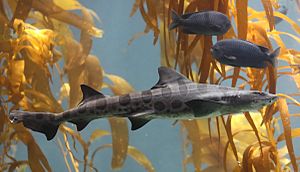Houndshark facts for kids
Quick facts for kids Houndsharks |
|
|---|---|
 |
|
| Leopard shark (Triakis semifasciata) | |
| Scientific classification |
|
| Kingdom: | Animalia |
| Phylum: | Chordata |
| Class: | Chondrichthyes |
| Order: | Carcharhiniformes |
| Family: | Triakidae J. E. Gray, 1851 |
| Subfamilies and genera | |
|
see text |
|
The Triakidae or houndsharks are a fascinating group of sharks. They belong to a family called Triakidae. There are about 40 different kinds, or species, of houndsharks. Scientists group them into nine main types, called genera.
These sharks are known for some special features. They have two large fins on their backs. These fins do not have any spines. Houndsharks also have an anal fin near their tail. Their eyes are oval-shaped and have special nictitating eyelids. These eyelids can help protect their eyes.
Houndsharks are usually small to medium-sized. They can be from about 37 centimeters (1.2 feet) to 220 centimeters (7.2 feet) long when fully grown. You can find them all over the world. They prefer warm and mild ocean waters. They like to swim near the seabed or in the middle of the water. They hunt for small fish and tiny creatures without backbones, like crabs or worms.
Scientists have found traces of ancient houndsharks. These fossils show that houndsharks have been around for a very long time. They date back to a period called the Cenomanian. This was a time when dinosaurs still roamed the Earth!
Exploring the Houndshark Family
Scientists like to organize living things into groups. This helps us understand them better. Houndsharks are divided into two main groups, or subfamilies. These groups are called Galeorhininae and Triakinae. Each subfamily contains several different types of houndsharks, known as genera.
Modern Houndshark Genera
Here are some of the living houndshark genera you might find today:
- Galeorhininae
- Furgaleus (known as the whiskery shark)
- Galeorhinus (also called the school shark)
- Gogolia (the sailback houndshark)
- Hemitriakis
- Hypogaleus (the blacktip tope)
- Iago
- Triakinae
- Mustelus (often called smooth-hounds)
- Scylliogaleus
- Triakis
Ancient Houndshark Relatives
We also know about many ancient houndsharks. These are only known from fossils. They show us how houndsharks have changed over millions of years. Scientists continue to discover new fossil species. These discoveries help us learn more about Earth's past.

